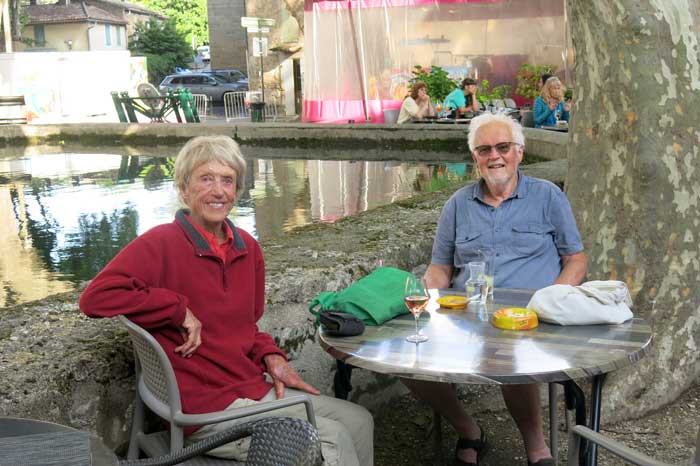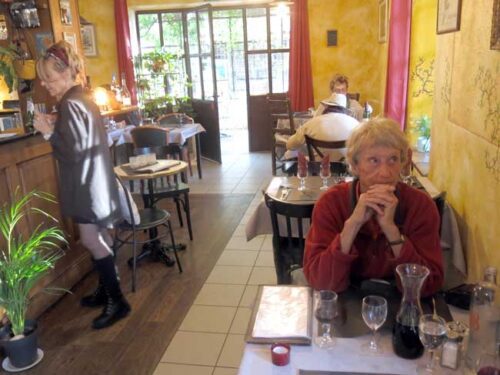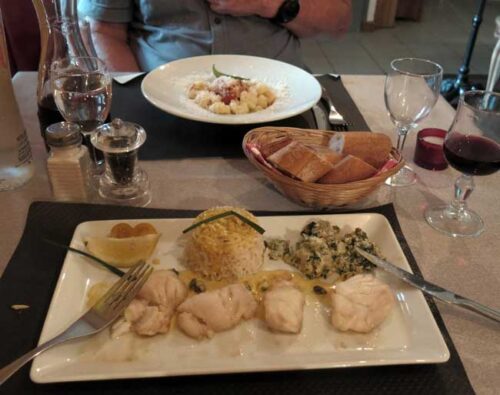Thursday, 25 May 2023
Distance 8 km
Duration 3 hours 10 minutes
Ascent 154 m, descent 166 m

As dawn crept up, there was an almost continuous growl of thunder and a sprinkle of rain, which rapidly got heavier. Soon it became such a downpour that we were more or less trapped in our tent for lack of other shelter.
There was no communal room, no overhanging roof at the café, no covered entrance to the office, nothing except the entry room of the shower block, in which there was nowhere to sit. So we stayed where we were, which was dispiriting to say the least.
After a while a voice called out “Are you there?” – it was our Dutch neighbour, living up to her country’s altruistic reputation, saying that they had put two folding chairs in the sanitaires for us.

We hurried across and settled gratefully into this relatively luxury, while people with streaming raincoats and umbrellas bade us a polite good morning as they arrived for their morning ablutions.
Meanwhile our neighbours had driven off, but after a while they reappeared and presented us with half a baguette, a croissant and a pain aux raisins, plus two mugs of coffee and some hot milk. I almost cried with gratitude. (We exchanged email addresses and subsequently kept in touch for a few months).
Fortified by this memorable act of kindness, and as the rain was lessening, we decided to start walking to Lourmarin, our destination for the day. We packed up our wet tent and its contents and set off, noticing, as we passed the café, that it was still closed, deserted and dismal at 11 am.

A few minutes after setting off along the road to Sannes (the D27), we took a small road to the right, which made its crooked way through an ocean of vines and finally delivered us to the hamlet of Roque Colombe.
This consisted of half a dozen surprisingly solid-looking houses, through which the road squeezed before continuing up the hill for another hundred metres or so, and then turning along the ridge, past a row of pencil pines, to what looked like olive farms.

According to our map, there was a track from this point which would lead us down to another road and then into Cucuron. As it turned out, this track was by no means obvious.
We thrashed around for a while until we thought we had found it, and followed it in the right general direction, increasingly worried that it was only an animal track and not the one we had been looking for.

Plunging down the slope through the scrub, we found ourselves in an olive grove, with neatly mown grass between the rows, and a house not far away.
All this seemed rather promising, but there was an impenetrable barrier of blackberry in the ditch separating us from the house, and in the end we had to battle our way up the hill by a different route, looking for a way through.
We finally found a road going up, which veered to the right, not the way that we wanted to go, but we had no choice.
It turned out to be the other end of the road with the row of pencil pines, and we duly arrived back at the same place that we had started from.

By now Keith was getting tired (the result of the pills he has to take), so we decided that the best idea would be to admit defeat and go back to the D27 that we had left more than two hours ago. There was a well-defined wheel track marked on the map which would take us directly down to it, so with renewed hope we set off.
As we descended, the open grassland gave way to ever thicker trees, and we arrived at a picnic table, around which the track looped and started heading up towards the houses of Roque Colombe.
There was no sign of a continuing track towards the highway, but we struggled on, hoping to find it lower down. By now we were in a dense forest, with fallen branches and rotted logs choked with vines everywhere.

Fighting our way onwards, more and more scratched and bruised, we heard at last the welcome hum of cars, and the road came into sight. The only trouble was that it was down a sheer drop of several metres.
We crept sideways until we found a less steep, but muddier, descent and slid down on our bottoms. When we reached the bitumen, we almost knelt down and kissed it, we were so pleased to see it. We normally despise bitumen, but in this case we loved it.
On this last slide Keith had caught his foot in a protruding root and twisted his knee, which we thought nothing of at the time. as we had other worries, such as how we were going to get to Lourmarin that day. It was already 2 pm and we were very tired.

Then we realised that the village of Cucuron was only a few kilometres further on. We had intended to have our morning tea in Cucuron, but spending the night there would be just as good, or even better, as it was a Plus Beau Village.
Luckily, there was a camping ground on this road, only a kilometre out of the village. It was a funny, old-fashioned place, no more than a grassy field attached to a vineyard, with the ablutions block at the back of the shed that served as the reception for the camping as well as for wine sales.
Despite its primitive exterior, the ablutions block was uncommonly flashy – the toilets had circular seats that automatically rotated and washed themselves after you rose. On the other hand, there were no lights, as we discovered that evening.

The field was occupied by many large vans and palatial. multi-roomed tents, most of them tucked under trees. We set up our simple shelter in a similar shady spot, then went to pay (€10.84), but the woman could only take cash and we did not have enough, so she said to pay in the morning, after we had been to the village for dinner.
We had showers and flopped down for a rest until it was time to go to the village in search of refreshments (and cash).
We noticed large signs scattered around the place proclaiming the virtues of composting, with pictures of the various worms, grubs, flies and moths that do the deed, and exhortations to the campers to put all their scraps into the bins provided.
Another huge van swooped in and was greeted with joy by a Dutch couple whose equally huge van was parked not far from us. The new arrivals were British, or rather Scottish, they said, although neither of them had a Scottish accent. Naturally all their conversation was in English, and we joined in, commiserating with them about Brexit and also about the lack of Scottish independence.

We found out that the newly-arrived woman had had three hip replacements and one shoulder reconstruction, which made Keith’s tally of one hip replacement fade into insignificance.
Despite all this, the poor thing could hardly walk and looked a wreck. We found out that the two couples have been meeting at this camping place every year since their children were small, and know the local area, and the owners of the vineyard, very well.
As the shadows lengthened, we set off to see the town, which was perched on a rocky knoll less than a kilometre away.
From a distance it did not look much of a climb but the little streets turned out to be painfully steep. We asked our way to a “distributeur de billets” (an ATM), as we needed cash to pay for the camping. When we found that, we also found that we were right next to the social centre of town, l’Étang.


This was a long, shallow pool, or bassin, fringed by massive old plane trees and surrounded by restaurants, hotels and bars – just our sort of place.
We slipped into a table near the water and ordered glasses of pastis and rosé to sip while we took in the deliciously relaxing atmosphere, so reminiscent of earlier trips and so rarely encountered this year.
For dinner we went down the street a little way to a restaurant that we had passed on the way up.

It had suddenly turned cold so we went inside and got a table, but later diners were asked to eat outside, or simply turned away, so we felt rather smug.
Keith chose gnocchi and I had a dish of cabillaud (codfish). With a basket of bread and a half-litre of wine, it was more than enough for our shrunken stomachs and we had to pour the remains of the wine into the small flask that I carry in my shoulder bag for just such occasions.
We strolled happily back to our little grassy home among the grapevines and caravans.